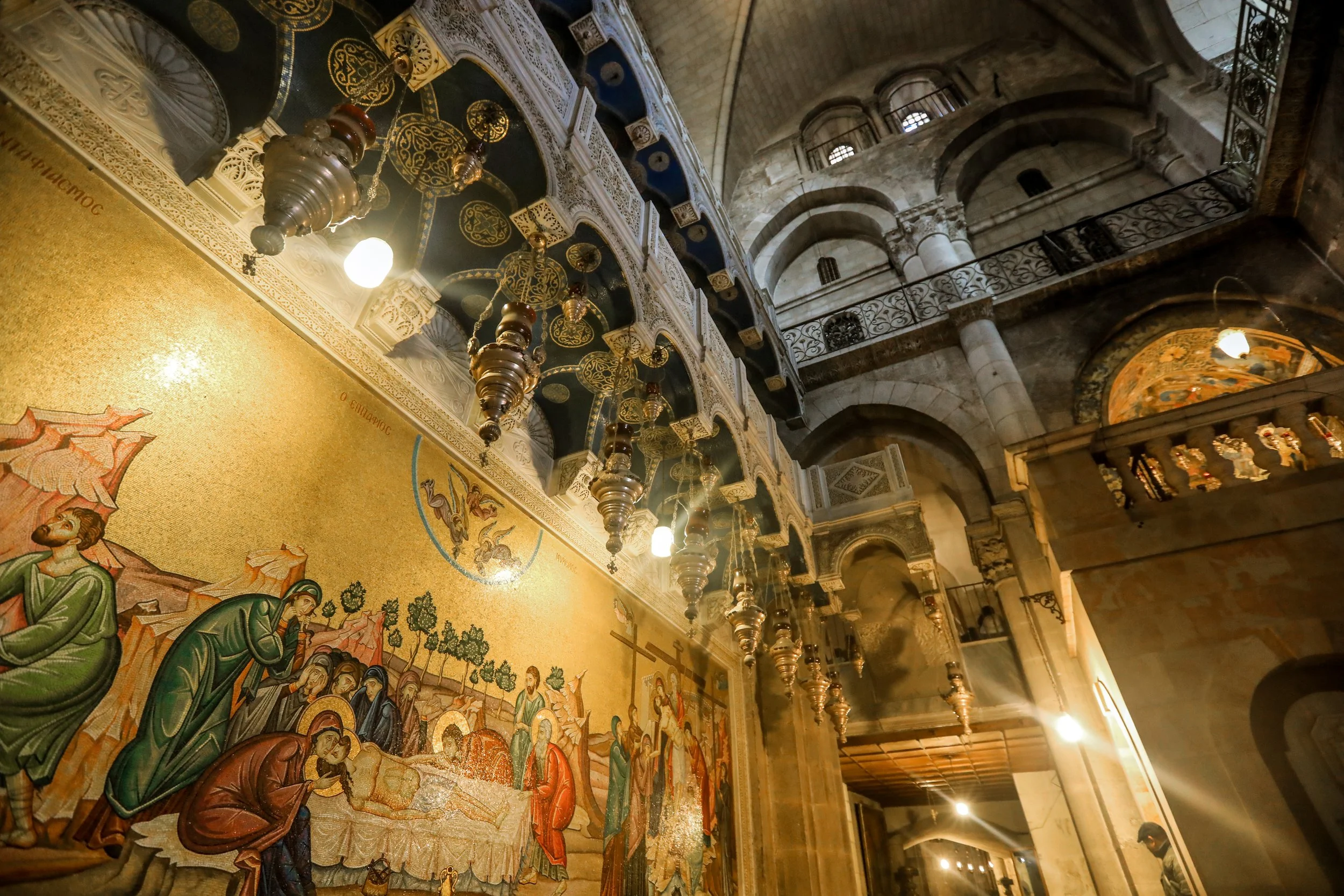How to Make Something Sacred
I did not realize how absent the sacred was in my life until I visited Israel eight years ago. The most popular tourist sites often bustled away much of the magic. It’s hard to be awestruck when you are fighting strangers for a view or waiting in a long line that ushers you in and out of the holy places as efficiently as possible. But there were quieter, off-the-beaten-path locations—the kind of spots you hit when you’ve already seen everything else. These often overlooked, B-list tourist sites, dedicated to lesser-known saints or obscure biblical events, nevertheless held a power that invited, absorbed, and quieted me.
In one of those spaces, we attended a brief worship service. Arriving early, we walked through the sanctuary, trying to identify what scenes were captured in various paintings, each one darkened almost beyond recognition by centuries of smoke and soot and incense. Here was the Council of Nicaea; there was John the Baptist; across the room was a saint we could not identify. Everything was lit by gold and candlelight. We were transported.
As the service began, we wanted to give respectful distance to the regular worshippers, so we found a bench along the side wall, towards the back of the room. Sitting down, I crossed one leg over the other, my left ankle resting on top of my right knee. And that’s when something happened that has weighed on me ever since.
A very old woman, who was clearly not a tourist, scowled at us. She looked how I imagine the prophetess Anna would have looked—as if “she never left the temple but worshipped night and day, fasting and praying” (Luke 2:37). She was pious, reverent… and not to be trifled with. After scowling at us, she made her way towards us, and quickly and firmly shoved my foot off my knee. “Keep your feet on the floor,” she said with a determined and mildly threatening look. I felt chastened and embarrassed for having been inadvertently disrespectful, but that’s not why I remember that moment so vividly.
I remember it because I haven’t been able to stop wondering if the overwhelming sense of awe that I experienced in that place was somehow connected to, or even dependent on, that old woman’s policing of my posture. It doesn’t seem very hospitable to knock someone’s foot onto the floor, but what if she was giving me a gift? What if she was trying to help me enter into the holiness of that place by teaching me how to avoid desecrating it? Perhaps we cannot experience the sacred until we are willing to learn what is forbidden to us.
And that is a troubling thought—especially to those of us with low-church Protestant sensibilities. In Churches of Christ, we have largely democratized and domesticated the holy. We do not have priests who are uniquely set apart to perform sacraments. Instead, we practice a priesthood of all believers where (almost) anyone can lead the prayer for communion, or baptize a new member, or perform a wedding. Communion is generally more open than it is closed, and if there is any gate-keeping, it is usually only our own un-baptized children who are barred from partaking in the Lord’s Supper. There is nowhere in the “sanctuary” where lay members are restricted from entering—in fact, we wouldn’t even call it a “sanctuary” to begin with. We prefer to call it an auditorium or a worship center because, after all, “the church is not a building, but the people gathered.” There is no such thing as “sacred space” for us. Even our wardrobes betray our preference for the common and casual. Most of the folks at my congregation would find it incredibly weird if I got up to preach while wearing a suit and tie, much less vestments or a Roman collar!
Don’t mishear me. If it sounds like I am critical of my own tradition, I can assure you that it has nothing to do with the practices I described above. Actually, many of those instincts—our simplicity, inclusivity, and lack of formal hierarchy between clergy and laypeople—are some of the traits I most cherish about our tradition. The practices I named are not points of contention that I hold against Churches of Christ. In fact, they are actually the things that keep me committed to this people and this way of practicing the faith.
And yet, I cannot help but wonder if those very characteristics are what prevent so many of us from experiencing a sense of the sacred as we worship together. If my life feels “dis-enchanted,” is it partly because there is nothing that I feel obligated to treat with reverence?
Or maybe I should ask a more troubling question: Is it possible that I resist treating anything as sacred because to do so would encroach on my freedom, my own self-assertion? I don’t want anything or anyone telling me, “No.” How dare anyone tell me how to sit or dress, or where I can or cannot go?!
But it seems to me that the sacred can only exist where there is a boundary. Where something is off-limits. Where guardrails are in place that prevent us from desecrating the holy.
If we want to draw near to God, perhaps we need to look for that cherubim with a flaming sword, guarding the way to paradise (Gen. 3:24).
If we want to walk on holy ground, perhaps we should heed the voice telling us to stop until we’ve removed our sandals (Exodus 3:5).
If we want to experience the sacred, perhaps we need old women telling us how to sit in church.







